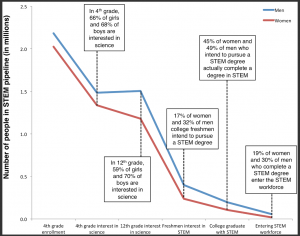Many scholars have written about the problems young girls face in middle school, high school and even college that have turned them away from STEM fields. Here, the research of Ming-Te Wang and Jessica Degol, as well as Jessica Ellis, Bailey Fosdick and Chris Rasmussen, is discussed. Wang and Degol’s research is based off of a U.S. Department of Education, National Center for Education Statistics survey of 2014, whereas Ellis, Fosdick and Rasmussen’s research is taken from a 2013 National Norms survey. Each of the articles examine the gender gap in STEM fields and how both society and educators can help increase interest in STEM in young girls.
————————————————————————————————————————————
The Problem:
In their research, Wang and Degol, discuss the underrepresentation of females in the math-intensive fields in STEM (2016). They found six different reasons for the lack of women in these career pathway fields. The six explanations are: cognitive ability, relative cognitive strengths, occupational interests or preferences, lifestyle values or work-family balance preferences, field-specific ability beliefs and gender-related stereotypes and biases (Wang & Degol, 2016).
Ellis, Fosdick and Rasmussen describe the leaky STEM pipeline problem in a similar way. The authors pinpoint that women are 1.5 times more likely to leave STEM pipeline after calculus compared to men (Ellis, Fosdick & Rasmussen, 2015). In their research they compare women and men with above-average mathematical abilities and found that women start and end the term with significantly lower mathematical confidence than men (Ellis, Fosdick & Rasmussen, 2015). This lack of confidence, they describe, is responsibility for the high departure rate of women.
————————————————————————————————————————————
The Reason Why:
In both works, the authors acknowledge that there are many reasons for the underrepresentation of women in STEM. The authors also agree that increasing STEM interest in girls at an early age is the key to increasing their participation in STEM later in life. Ellis, Fosdick and Rasmussen state that in 4th grade, 66% of girls and 68% of boys are interested in science (2015). Yet in 12th grade, 59% of girls and 70% of boys

are interested in science (Ellis, Fosdick & Rasmussen, 2015). The lack of confidence girls gain over the course of Calculus contributes to the confidence they have when entering co
llege and thinking about whether they can be successful in STEM and for many of them the answer is no. In their research, Wang and Degol concur that science career interests need to be established in high school with math intensive classes and that this barrier in math ability emerges in late adolescence (Wang & Degol, 2016).
————————————————————————————————————————————
Possible Solutions:
Wang and Degol suggest that in order to improve the number of women in STEM, educators need to: intervene early to cultivate interest in math and science, break down the stereotypes about women in stem, and provide more female role models for girls and women in STEM fields (2016). Providing more female role models is the most important solution. This way, girls can begin to associate the word “girls” with “math” and “science” as early as possible (Wang and Degol, 2016). Ellis, Fosdick and Rasmussen agree, having peer support systems, successful female STEM scientist and more confidence early on in their math and science classes is the key to attaining more girls in STEM (2015).
